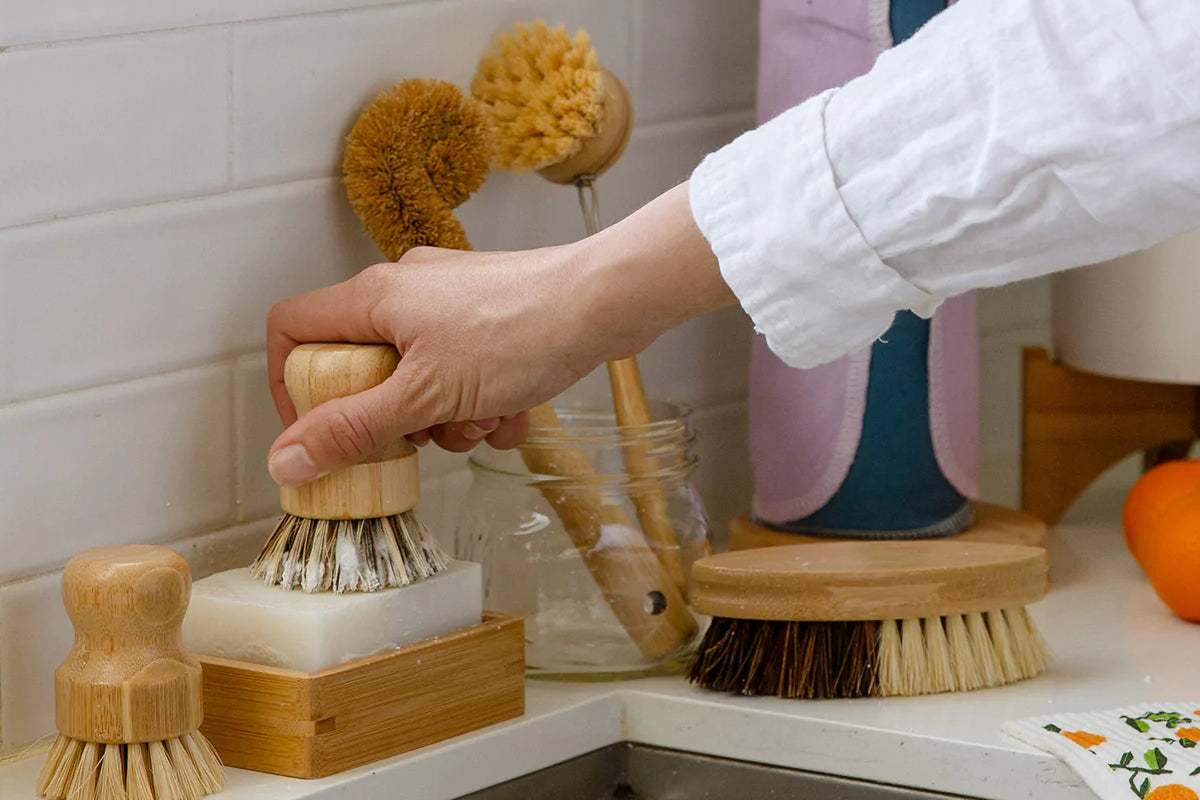6 Sustainable Dish Brush Alternatives That Are Completely Plastic Free

Cut down on waste by switching to zero waste dish brushes! Here are our six favorite brushes that are effective, reusable, compostable, and safe for the planet.
Estimated Read Time: 7 minutes
Let’s be real honest for a second — washing dishes kind of sucks. No matter how long you spend washing the largest pile, there are always more! Sure, every now and then it can be easy and kind of cathartic, but for the most part it’s a chore.
So when you find a good dish tool that makes washing dishes a little less awful, you want to stick with it! We totally get it!
That’s why we went through multiple manufacturers to find *the perfect* zero waste dish brushes that are good for the planet, good for your dishes, and good for your mental health.
Because we want clean dishes that don’t hold bacteria, release microplastics into the environment, or sit in a landfill for hundreds of years and we think you deserve the same.
Keep reading to see our 6 favorite zero waste dish brushes, alternatives uses for each one, cleaning instructions, how to care for them, and how to dispose of them!
How to Clean Zero Waste Dish Brushes
Eco-friendly dish brushes are more hygienic than sponges or cloths which allow bacteria to get trapped and grow! But you should still give your dish brushes a clean every now and then. Here’s how!
- Take a fork and comb through the brush to release any lingering debris.
- Combine 1 cup water + 1 cup vinegar (white distilled)+ 1 tsp dish soap
- Place the dish brushes face down in the solution & soak for 1 hour
- Remove it, rinse it in warm water, let it air dry on a towel
This can be used on any of the brushes. The sponge cloth can either be boiled or run through the dishwasher to keep it sanitary.
6 of the Best Eco-Friendly Dish Brushes to Create a Zero Waste Kitchen!
1. Long Handle Dish Brush
How to Use:
Rub the wet brush directly on the dish soap bar or apply liquid soap on the brush. Wash dishes as normal! When ready to replace the head, detach the old one, compost it, and reattach the new one.
Alternative Uses:
The long handle makes it great for cleaning surfaces like the counter, stove, sink, and hard to reach places like the back of the fridge 👀.
2. Short Handle Dish Brush
With a handle made from fast growing moso bamboo and strong agave fiber bristles, this shorty is easy enough for anyone to use and makes doing dishes a breeze. Agave fiber bristles are sturdy yet soft enough for any delicate dishes or cleaning needs.
How to Use:
This brush has a round handle that’s easy to hold onto! Rub the wet brush directly on the dish soap bar or apply liquid soap on the brush. Scrub as normal!
Alternative Uses:
This brush can alternatively be used to clean counters, bathrooms, floors, and pretty much anywhere else that needs scrubbing!
3. Pot Scrubber
The pot scrubber has tougher bristles and is a must-have dish brush. With an easy to hold round handle made from moso bamboo and a bristle blend of sisal + palmyra fibers (derived from palm and agave plants), this brush is perfect for those items that need tough scrubbing.
How to Use:
Grab the rounded handle, rub the wet bristles directly on the dish soap bar or apply liquid soap on the brush. Scrub as normal.
Alternative Uses:
This brush can be used to clean showers, floors, sinks, and anything stuck to a surface that needs to come off.
4. Vegetable Brush
Don’t let its name fool you — the vegetable brush is a medium-soft bristled multipurpose tool that’s a must-have in your kitchen arsenal. A sturdy oval shaped bamboo handle is joined by bristles made from a yucca and agave blend.
How to Use:
Its medium-soft bristle strength makes this brush versatile. It can be a vegetable scrubber, laundry stain remover, a floor/bathroom scrubber, or its oval shape makes it perfect for cutting boards. The possibilities are endless!
Alternative Uses:
When using on laundry, apply a stain remover to the garment, wet the brush and gently scrub at the stain in a circular motion. Use it on dishes as you would any other scrub brush.
5. Bamboo Bottle Brush
Goodbye are the days of trying to make your hand smaller to fit in a skinny cup or bottle. And forget using a tufted brush that splashes water and soap everywhere as it's yanked out of the bottle. Made with a bamboo handle and coconut fibers (a byproduct of the coconut industry) there’s no such thing as hard to clean glassware anymore.
How to Use:
Rub the wet brush on the dish soap block or apply liquid soap directly to the brush and wash as usual. Alternatively, add soap and water to the bottle/glass first then use the bottle brush to scrub and mix it around.
Alternative Uses:
The bristled hook at the top of the brush makes it great for cleaning toilets, behind faucets, or any hard to reach corners. But please not at the same time, use a separate brush for each!
6. Biodegradable Kitchen Sponges
Made from wood pulp, sponge cloths are an easy replacement for plastic-based sponges. Each towel can hold up to 20x its weight in water (.75 cups!) and they’re soft enough to use on any surface or dish.
How to Use:
For dishes get the sponge a little wet then rub directly on a solid dish soap or add liquid soap to it. Lather it up and wash dishes as you would with a dishrag. For cleaning, apply the surface cleaner, slightly dampen the cloth and wipe. To use as a paper towel, apply the dry sponge cloth to the surface and wait until it’s absorbed all the liquid it can. When it’s soaked, ring it out and repeat as needed.
Alternative Uses:
This multipurpose cloth can be used for dishes, cleaning, or as a paper towel replacement! When used as paper towels, each cloth can replace up to 17 rolls of paper towels.
Help Your Dish Brushes Last Longer

Follow a few simple rules to keep your brushes in excellent condition and lasting longer!
- Don’t run the dish brushes through the dishwasher, only the sponge cloth!
- Don’t let them soak in water for long periods of time (outside of cleaning).
- Let them dry after use/store in a dry area (on a towel, etc).
- Oil wood handles to keep them from dramatic cracking.
- Run the brushes through the cleaning process when the bristles get frayed.
How to Dispose of Zero Waste Dish Brushes

Image by Manfred Antranias Zimmer
The best part of switching to eco-friendly dish brushes is that each one can be broken down back into the earth or recycled to minimize its impact on the environment.
Dish brushes only made of wood and natural fibers (sponge cloth, pot scrubber, short handled brush, vegetable scrubber, and bamboo bottle brush) can all be composted or buried in a garden.
The long handled dish brush’s natural elements (the handle, and the head) can be composted or buried in the garden and the metal can be recycled.
There are so many other zero waste kitchen products available that we didn’t cover in this blog! Whatever your preference, we have an eco-friendly solution at ZeroWasteStore! No matter how large or small the sustainable changes are that you’re making, everything you do matters. Let’s all #rethinkourwaste!
Other Blogs You Might Find Helpful:
- An Easy Stress Relieving Sustainable Kitchen Routine to Try Now
- Hack Your Way to a Zero Waste Kitchen With These Easy Swaps
- Zero Waste Home Products and How to Dispose of Them Properly
- 5 Zero Waste Dish Soap Bars (with Suds!) For Super Clean Dishes
- Why You Need to Make the Switch to Zero Waste Dish Soap



























Comments (0)